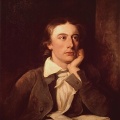Life is short, art is eternal.
Hippocrates
 This quote highlights the life of the young poet as never before. During the Victorian era, John Keats became one of Britain's most popular and textbook poets. The Pre-Raphaelites especially admired him. The seal of genius is marked not only by the poems, but also by the letters of Keats. The poet's work still attracts the attention of readers and literary critics.
This quote highlights the life of the young poet as never before. During the Victorian era, John Keats became one of Britain's most popular and textbook poets. The Pre-Raphaelites especially admired him. The seal of genius is marked not only by the poems, but also by the letters of Keats. The poet's work still attracts the attention of readers and literary critics.
The poet of the younger generation of English romantics was born on October 31, 1795 in London in the family of a livery stable Keeper. He was the first child of Thomas Keats and Frances Keats (Jennings). This was followed by his brothers George, Thomas, Edward, and sister Frances Mary.
His family was friendly and well-off. But as a young man, John lost his parents. John's father was killed when he fell from his horse. His mother and younger brother soon died of tuberculosis. The writer's illness soon took him to the next world. Due to the death of his parents, John was not able to continue his education, and he also could not work, although he tried to get a job in a detective agency. John left the hospital, where he was determined to be an apprentice pharmacist. He began to live in the care of friends, and also plunged into the beautiful world of books and poetry. John tried to resume his studies, and he seriously considered becoming a doctor and connecting his life with medicine. Still, the love of poetry was stronger. In 1816, on May 5, his first poem appeared in the Explorer magazine, which was called "Loneliness".
In his short and marred by the illness of life, Keats published almost everything that is written. In less than 4 years, he published three books – two collections of poetry, which included sonnets, odes, ballads, poems "Lamia", "Isabella", and the poem "Endymion" in a separate edition. Keats communicated with like - minded people and made up for the lack of literary education. Keats' lyrics, as befits romantic poetry, were a state of mind and heart translated into poetic language. After analyzing the poems of Keats, we can say that they were struck by the flowery, and at times excessive contrivance, and an unexpected craving for originality.
Keats was almost always surrounded by friends, but he also had detractors. They were sensitive to the poet's criticism of them. Keats paid dearly for his sarcastic and precise remarks. English magazines sent huge reviews to the poet, in which they smashed his poems to smithereens. John quite early found his genre in poetry – the sonnet. All his life, John was very demanding of himself. He traveled through Ireland and Scotland, and the mountain scenery aroused his imagination. After returning from a trip, John was staying with a friend. At the same time, he met Fanny brown, a girl who lived next door. They were engaged in 1818. A year later, John's health deteriorated. He asked his fiancée Fanny to break off the engagement, to which she did not agree. Keats experienced conflicting feelings, poems from the series "Lines to Fanny" are filled with pain and love.
In the last years of his life, Keats seemed to feel that he was about to die. He worked on his next poem "Hyperion", which was based on a mythological story. Work was in full swing, but in 1820, his brother died, and John was forced to abandon work on the poem. Later, he often returned to the story, but never finished the work. The best works of the poet are considered to be his odes in 6 poems, written in 1819. The last ode "To Autumn" was written in September 1819. A year later, it became clear that John would not survive the winter in England. He moved to Italy, but on the morning of February 23, 1821, the young poet died in Rome. The gravestone is carved with an epitaph written by him: "Here lies the one whose name was written on the water."
Keats ' poetry brought a new element of Hellenism to English romanticism, as well as a cult of beauty and harmonious enjoyment of life. Now he is given a place in English literature on a par with Byron and Shelley, although his poems differ markedly from the poems of the latter in mood and inner content.
Nazira Artykbayeva, Librarian of the International Book Department

